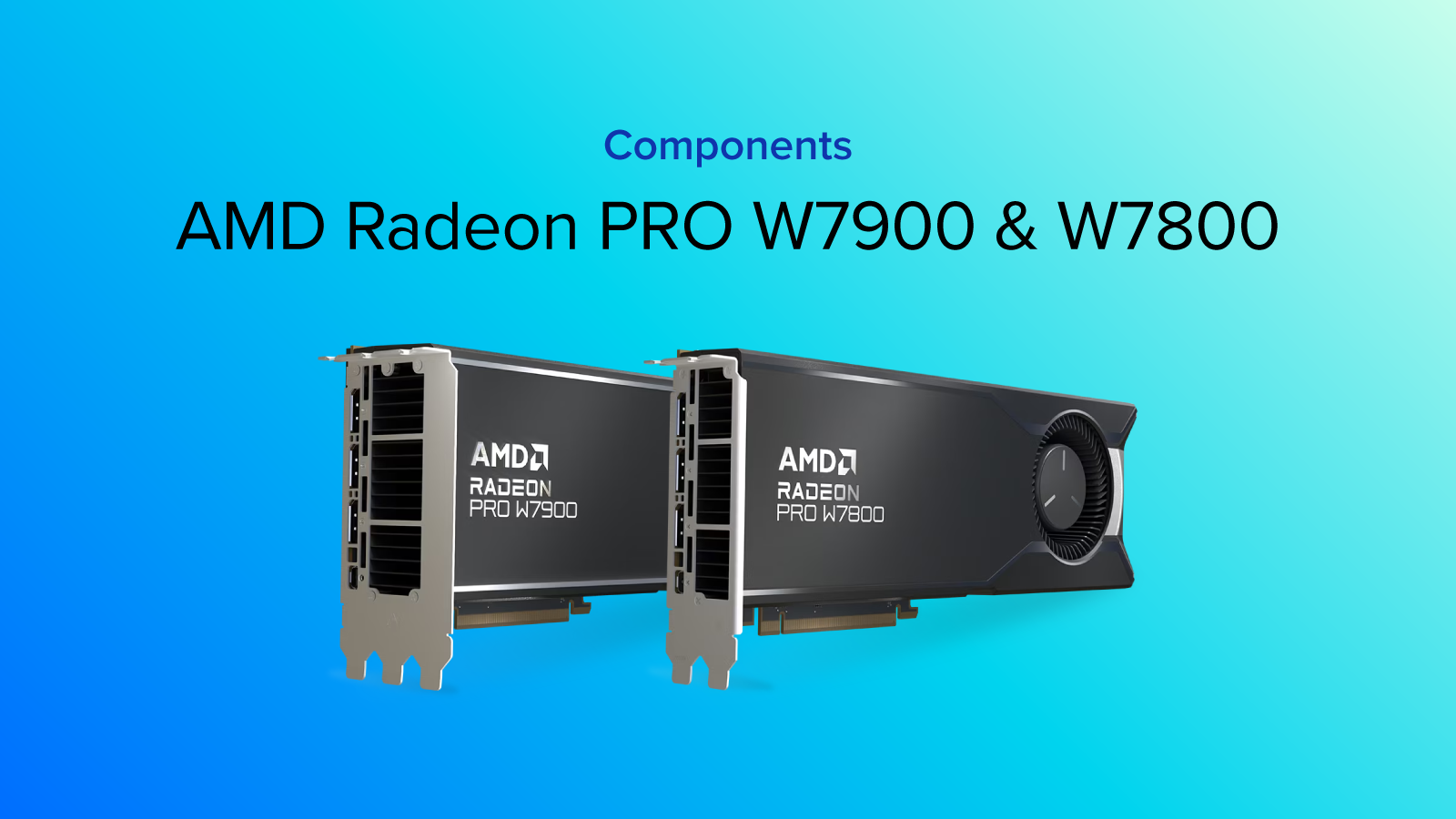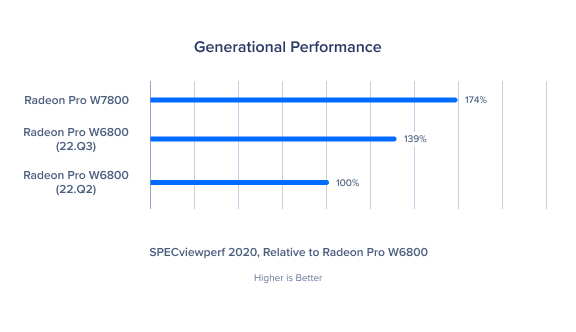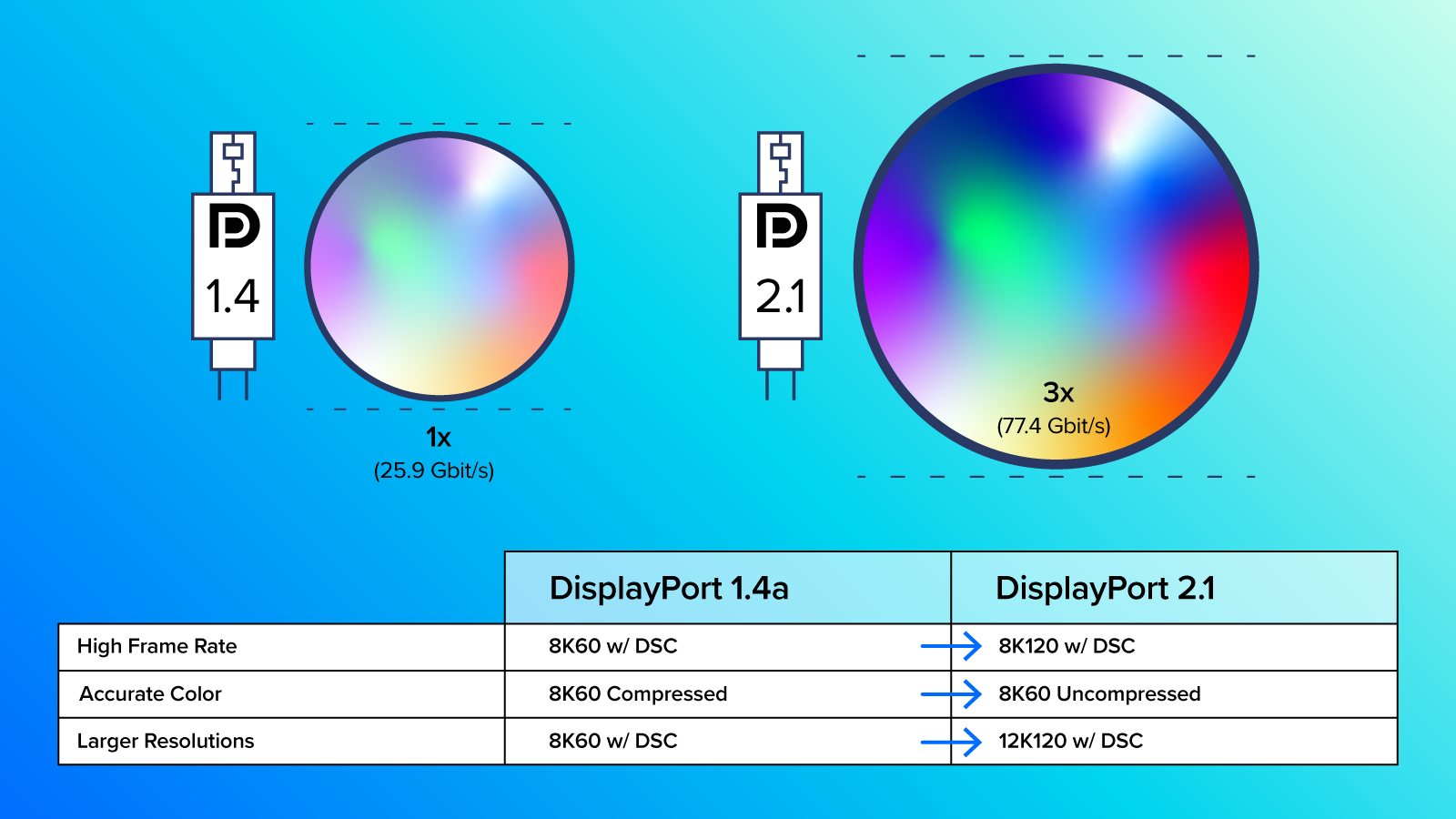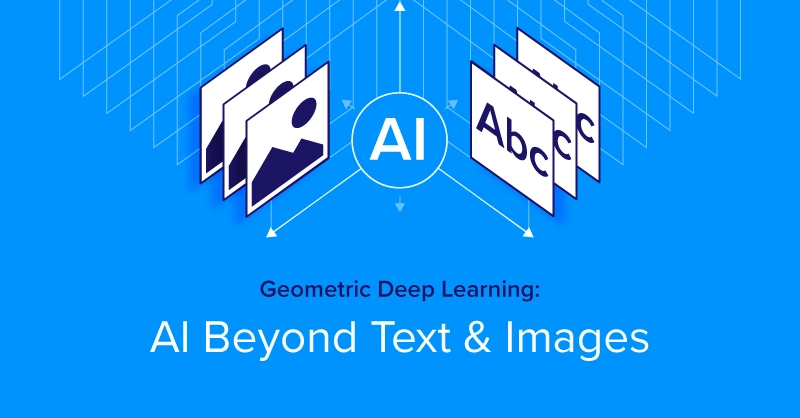
RDNA3 Workstation Graphics Cards
Workstation Graphics Cards are the unsung hero of development and productivity. The consumer market is more focused on the best performance and the highest framerates in their favorite title. However, the development of those games and the 3D assets that make up the entire scene of your favorite games used a workstation GPU for design.
The AMD Radeon PRO W7900 and W7800 are AMD’s next generation of professional workstation GPUs specially designed for computer-aided design, game development, and content creation. These cards have stability and reliability in mind so you can be sure the GPU will operate at optimal performance with little worry of overloading and crashing.
While AMD and NVIDIA are battling over their place in the market to be the top dog in productivity, AMD is making strides in delivering compelling workstation graphics card perfomrnace. AMD’s flagship Radeon PRO GPUs offer more than meets the eye to push their way into being a competitive option for your next productivity workstation.
.jpg?format=webp)
Introducing the AMD Radeon PRO W7900 and W7800
The AMD Radeon PRO W7900 and W7800 use AMD’s RDNA 3 architectures with a hybrid chiplet architecture blending 6nm and 5nm chiplets for lower cost and improved efficiency. The 6nm larger die handles the memory cache while the smaller more intricate die handles the graphics compute die. Combined, it can deliver compelling performance given its unique and groundbreaking construction. We will compare the new generation Radeon PRO W7900 and W7800 with last generation Radeon PRO W6800
AMD Radeon PRO W7900 First Look
Released in the last year, the flagship consumer graphics card Radeon RX 7900XTX and the W7900 look to be the workstation equivalent with the exception of a 24GB more VRAM. Let's look at the difference between this generation and the last generation Radeon PRO W6800.
| Radeon PRO W7900 | Radeon PRO W6800 | |
|---|---|---|
| GPU Architecture | AMD RDNA™ 3 | AMD RDNA™ 2 |
| Stream Processors | 6144 | 3840 |
| Compute Units | 96 | 60 |
| Peak Single Precision (FP32) | 61.3 TFLOPS | 17.82 TFLOPS |
| GPU Memory | 48GB | 32GB |
| Interface | 384-bit | 256-bit |
| Bandwidth | Up to 864 GB/s | Up to 512 GB/s |
| Base Clock | 1.855 GHz | 2.075 GHz |
| Boost Clock | 2.495 GHz | 2.320 GHz |
| TGP | 295W | 250 W |
| Display Output | 3x Display Port 2.1, 1x Mini Display Port 2.1 | 6x Mini-DisplayPort™ 1.4 |
Comparing the last generation RDNA 2 Radeon PRO W6800, we can see a considerable spec jump with additional memory, bandwidth, performance, and boost clock speeds. While the base clock speed is lower, we can expect the GPU to perform well above that clock speed with ample cooling and power.
When interacting with 3D objects containing massive amounts of polygons, or simulating fluid dynamics on detailed models, more GPU memory and bandwidth can deliver an even smoother experience especially since computer graphics and simulations are becoming more realistic and more complex.

Looking at the performance graphs provided by AMD, we can see an over double the performance in SPECviewperf 2020 versus W6800 before the driver update last year. With up-to-date drivers on the W6800, the generational jump is still a significant 70% increase. Since the Radeon PRO W7900 is built on a new architecture RDNA3, we hope to expect future drivers to fully optimize the performance of the first chiplet workstation graphics card.
Exxact specializes in GPU-accelerated computing from 3D Content Creation all the way to AI and Deep Learning. Explore our workstations supporting AMD Radeon PRO graphics cards.
AMD Radeon PRO W7800 First Look
The AMD Radeon PRO W7800 is a similar story. We will compare it to the last generation Radeon PRO W6800 to see what changed.
| Radeon PRO W7800 | Radeon PRO W6800 | |
|---|---|---|
| GPU Architecture | AMD RDNA™ 3 | AMD RDNA™ 2 |
| Stream Processors | 4480 | 3840 |
| Compute Units | 70 | 60 |
| Peak Single Precision (FP32) | 45.2 TFLOPS | 17.82 TFLOPS |
| GPU Memory | 32GB | 32GB |
| Interface | 256-bit | 256-bit |
| Bandwidth | Up to 576 GB/s | Up to 512 GB/s |
| Base Clock | 1.855 GHz | 2.075 GHz |
| Boost Clock | 2.499 GHz | 2.320 GHz |
| TGP | 260W | 250 W |
| Display Output | 3x DisplayPort 2.1, 1x Mini DisplayPort 2.1 | 6x Mini-DisplayPort™ 1.4 |
Comparing the last generation workstation cards, we can see a floating-point performance increase of about 27%. While it is not a direct performance increase to workloads it gives a good ballpark as to what to expect from this new generation of workstation graphics cards.

Judging by the SPECviewperf 2020 numbers from AMD, we see a sizable 35% increase over the W6800. By naming convention alone, the Radeon PRO W7800 is the true successor, and the performance graphs showcase the innovations that the multi-chiplet architecture of RDNA3 can deliver at a marginal 10W TDP increase.
For the AMD Radeon PRO W7800’s dual slot form factor allows 4-GPU configurations in standard desktop workstation chassis just like the W6800 whereas the Radeon PRO W7900’s larger triple slot would only support 2-GPU configurations in standard workstation chassis. If your workload values more GPU cores, a 4-way W7800 would yield better results. Otherwise, a 1 or 2 GPU W7900 configuration is more than enough to handle a majority of applications on better clock speeds and memory bandwidth.
The big reason to consider this generation AMD Radeon PRO workstation GPUs is DisplayPort 2.1. AMD calls their incorporation of DisplayPort 2.1 the AMD Radiance Display featuring 12-bit HDR and full coverage of the REC2020 color space for incredible color accuracy. With support for DisplayPort™ 2.1, experience breathtaking visuals at 8K60Hz uncompressed versus the current standard DisplayPort 1.4 found in graphics cards released relatively recently which only supports 8K 30Hz uncompressed.

AMD’s new graphics cards adds hardware accelerated AV1 encoding and decoding up to 8K60. It supports two simultaneous encode or decode streams for AVC and HEVC particularly useful for video exporting and streaming enjoying fast video compression and efficiency by offloading the video rendering and compression of to the GPU.
It is already known in the market that NVIDIA has a foothold in optimized support in various applications but that’s not where AMD is looking to compete. Head to heads will show a performance battle but where AMD looks to trade blows is the pricing. AMD Radeon PRO W7900 and W7800 have an MSRP of $3,999 and $2,499 price tag respectively whereas the new NVIDIA RTX flagship is well beyond double. If AMD can squeeze at least half the performance of these highly favored NVIDIA cards, it begs the question, does team green or team red offer a better performance for the dollar?
.jpg?format=webp)
Final Remarks
Our favorite applications are still optimized for CUDA on NVIDIA GPUs, but we are seeing traction to support OpenCL the language that AMD uses for their GPU architecture. As more and more users choose AMD to slot into their workstations, the more we can see adoption in optimizing support on OpenCL to level the playing field for more competition and thus more innovation.
First starts adopting more Team Red GPUs, then comes the continuous and virtuous cycle of hardware and software. That includes the market saturation of even AMD’s exciting consumer graphics cards. With more AMD GPUs the better the driver iterations get, and the more performance we can squeeze out of our hardware.
That said, AMD Radeon PRO W7800 and W7900 are by no means the fastest workstation GPU on the market for content creation and design, but it is one of the more exciting ones at their price for performance. Exxact Corp is proud to offer the AMD Radeon PRO W7800 and W7900 upon request in your next workstation.
Have any questions about your next workstation upgrade?
Contact us today and our experienced engineers can deliver performance you can depend on.

Quick Look - AMD Radeon PRO W7900 & W7800
RDNA3 Workstation Graphics Cards
Workstation Graphics Cards are the unsung hero of development and productivity. The consumer market is more focused on the best performance and the highest framerates in their favorite title. However, the development of those games and the 3D assets that make up the entire scene of your favorite games used a workstation GPU for design.
The AMD Radeon PRO W7900 and W7800 are AMD’s next generation of professional workstation GPUs specially designed for computer-aided design, game development, and content creation. These cards have stability and reliability in mind so you can be sure the GPU will operate at optimal performance with little worry of overloading and crashing.
While AMD and NVIDIA are battling over their place in the market to be the top dog in productivity, AMD is making strides in delivering compelling workstation graphics card perfomrnace. AMD’s flagship Radeon PRO GPUs offer more than meets the eye to push their way into being a competitive option for your next productivity workstation.
.jpg?format=webp)
Introducing the AMD Radeon PRO W7900 and W7800
The AMD Radeon PRO W7900 and W7800 use AMD’s RDNA 3 architectures with a hybrid chiplet architecture blending 6nm and 5nm chiplets for lower cost and improved efficiency. The 6nm larger die handles the memory cache while the smaller more intricate die handles the graphics compute die. Combined, it can deliver compelling performance given its unique and groundbreaking construction. We will compare the new generation Radeon PRO W7900 and W7800 with last generation Radeon PRO W6800
AMD Radeon PRO W7900 First Look
Released in the last year, the flagship consumer graphics card Radeon RX 7900XTX and the W7900 look to be the workstation equivalent with the exception of a 24GB more VRAM. Let's look at the difference between this generation and the last generation Radeon PRO W6800.
| Radeon PRO W7900 | Radeon PRO W6800 | |
|---|---|---|
| GPU Architecture | AMD RDNA™ 3 | AMD RDNA™ 2 |
| Stream Processors | 6144 | 3840 |
| Compute Units | 96 | 60 |
| Peak Single Precision (FP32) | 61.3 TFLOPS | 17.82 TFLOPS |
| GPU Memory | 48GB | 32GB |
| Interface | 384-bit | 256-bit |
| Bandwidth | Up to 864 GB/s | Up to 512 GB/s |
| Base Clock | 1.855 GHz | 2.075 GHz |
| Boost Clock | 2.495 GHz | 2.320 GHz |
| TGP | 295W | 250 W |
| Display Output | 3x Display Port 2.1, 1x Mini Display Port 2.1 | 6x Mini-DisplayPort™ 1.4 |
Comparing the last generation RDNA 2 Radeon PRO W6800, we can see a considerable spec jump with additional memory, bandwidth, performance, and boost clock speeds. While the base clock speed is lower, we can expect the GPU to perform well above that clock speed with ample cooling and power.
When interacting with 3D objects containing massive amounts of polygons, or simulating fluid dynamics on detailed models, more GPU memory and bandwidth can deliver an even smoother experience especially since computer graphics and simulations are becoming more realistic and more complex.

Looking at the performance graphs provided by AMD, we can see an over double the performance in SPECviewperf 2020 versus W6800 before the driver update last year. With up-to-date drivers on the W6800, the generational jump is still a significant 70% increase. Since the Radeon PRO W7900 is built on a new architecture RDNA3, we hope to expect future drivers to fully optimize the performance of the first chiplet workstation graphics card.
Exxact specializes in GPU-accelerated computing from 3D Content Creation all the way to AI and Deep Learning. Explore our workstations supporting AMD Radeon PRO graphics cards.
AMD Radeon PRO W7800 First Look
The AMD Radeon PRO W7800 is a similar story. We will compare it to the last generation Radeon PRO W6800 to see what changed.
| Radeon PRO W7800 | Radeon PRO W6800 | |
|---|---|---|
| GPU Architecture | AMD RDNA™ 3 | AMD RDNA™ 2 |
| Stream Processors | 4480 | 3840 |
| Compute Units | 70 | 60 |
| Peak Single Precision (FP32) | 45.2 TFLOPS | 17.82 TFLOPS |
| GPU Memory | 32GB | 32GB |
| Interface | 256-bit | 256-bit |
| Bandwidth | Up to 576 GB/s | Up to 512 GB/s |
| Base Clock | 1.855 GHz | 2.075 GHz |
| Boost Clock | 2.499 GHz | 2.320 GHz |
| TGP | 260W | 250 W |
| Display Output | 3x DisplayPort 2.1, 1x Mini DisplayPort 2.1 | 6x Mini-DisplayPort™ 1.4 |
Comparing the last generation workstation cards, we can see a floating-point performance increase of about 27%. While it is not a direct performance increase to workloads it gives a good ballpark as to what to expect from this new generation of workstation graphics cards.

Judging by the SPECviewperf 2020 numbers from AMD, we see a sizable 35% increase over the W6800. By naming convention alone, the Radeon PRO W7800 is the true successor, and the performance graphs showcase the innovations that the multi-chiplet architecture of RDNA3 can deliver at a marginal 10W TDP increase.
For the AMD Radeon PRO W7800’s dual slot form factor allows 4-GPU configurations in standard desktop workstation chassis just like the W6800 whereas the Radeon PRO W7900’s larger triple slot would only support 2-GPU configurations in standard workstation chassis. If your workload values more GPU cores, a 4-way W7800 would yield better results. Otherwise, a 1 or 2 GPU W7900 configuration is more than enough to handle a majority of applications on better clock speeds and memory bandwidth.
The big reason to consider this generation AMD Radeon PRO workstation GPUs is DisplayPort 2.1. AMD calls their incorporation of DisplayPort 2.1 the AMD Radiance Display featuring 12-bit HDR and full coverage of the REC2020 color space for incredible color accuracy. With support for DisplayPort™ 2.1, experience breathtaking visuals at 8K60Hz uncompressed versus the current standard DisplayPort 1.4 found in graphics cards released relatively recently which only supports 8K 30Hz uncompressed.

AMD’s new graphics cards adds hardware accelerated AV1 encoding and decoding up to 8K60. It supports two simultaneous encode or decode streams for AVC and HEVC particularly useful for video exporting and streaming enjoying fast video compression and efficiency by offloading the video rendering and compression of to the GPU.
It is already known in the market that NVIDIA has a foothold in optimized support in various applications but that’s not where AMD is looking to compete. Head to heads will show a performance battle but where AMD looks to trade blows is the pricing. AMD Radeon PRO W7900 and W7800 have an MSRP of $3,999 and $2,499 price tag respectively whereas the new NVIDIA RTX flagship is well beyond double. If AMD can squeeze at least half the performance of these highly favored NVIDIA cards, it begs the question, does team green or team red offer a better performance for the dollar?
.jpg?format=webp)
Final Remarks
Our favorite applications are still optimized for CUDA on NVIDIA GPUs, but we are seeing traction to support OpenCL the language that AMD uses for their GPU architecture. As more and more users choose AMD to slot into their workstations, the more we can see adoption in optimizing support on OpenCL to level the playing field for more competition and thus more innovation.
First starts adopting more Team Red GPUs, then comes the continuous and virtuous cycle of hardware and software. That includes the market saturation of even AMD’s exciting consumer graphics cards. With more AMD GPUs the better the driver iterations get, and the more performance we can squeeze out of our hardware.
That said, AMD Radeon PRO W7800 and W7900 are by no means the fastest workstation GPU on the market for content creation and design, but it is one of the more exciting ones at their price for performance. Exxact Corp is proud to offer the AMD Radeon PRO W7800 and W7900 upon request in your next workstation.
Have any questions about your next workstation upgrade?
Contact us today and our experienced engineers can deliver performance you can depend on.




